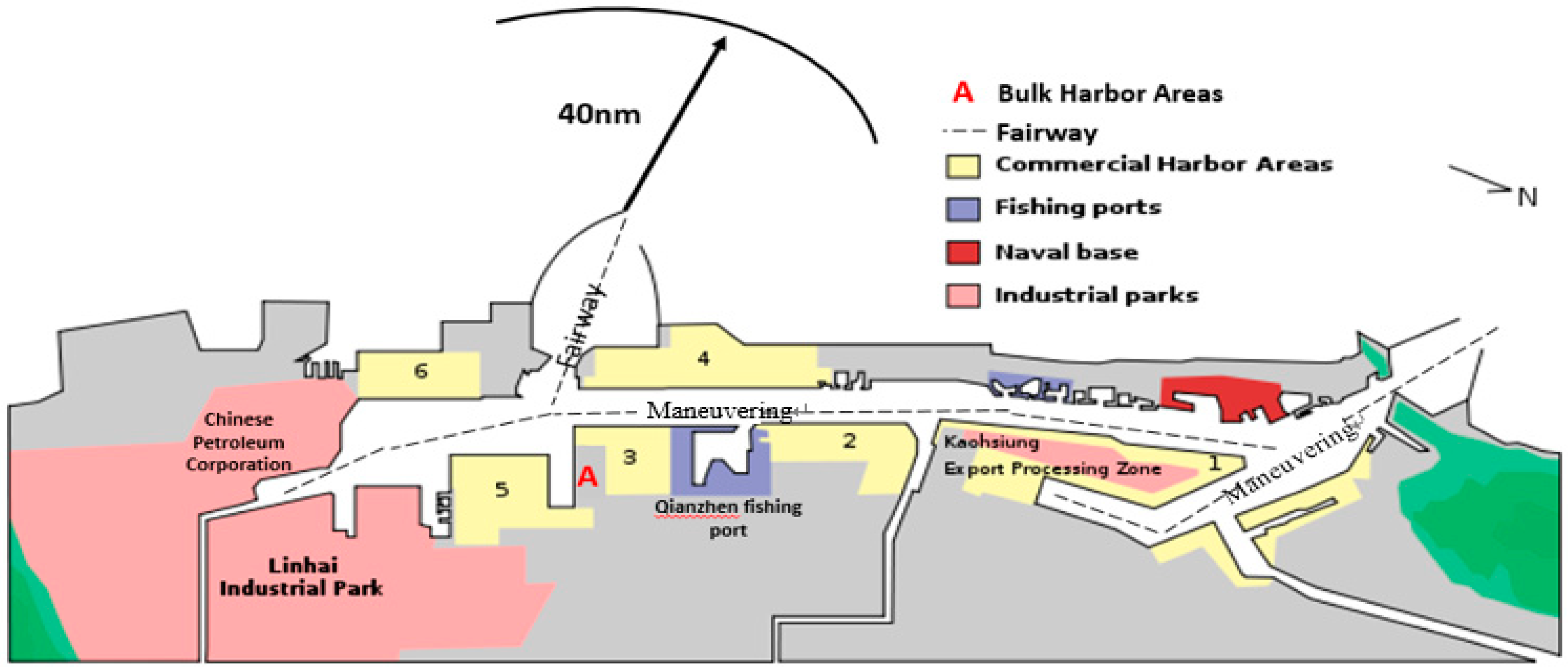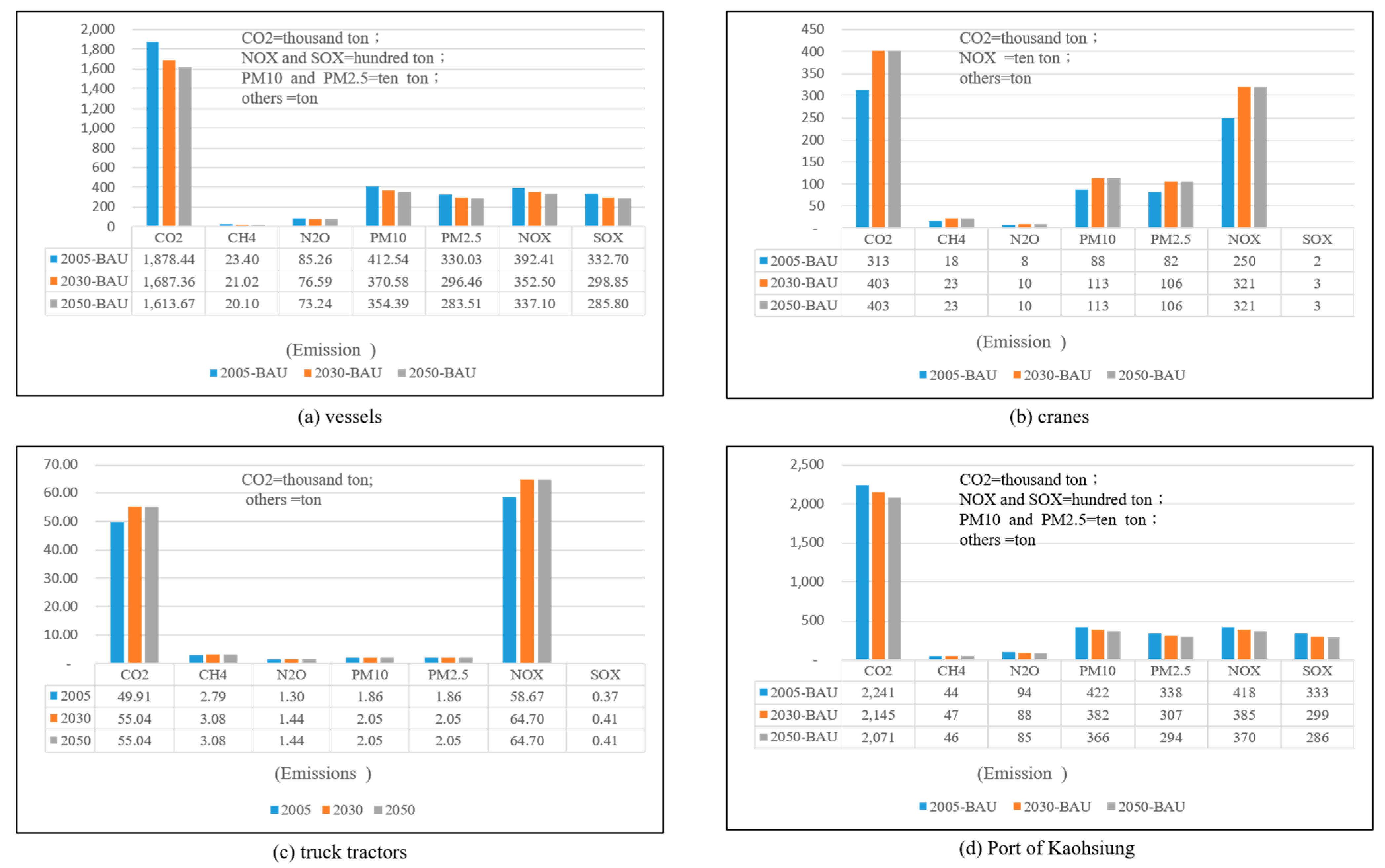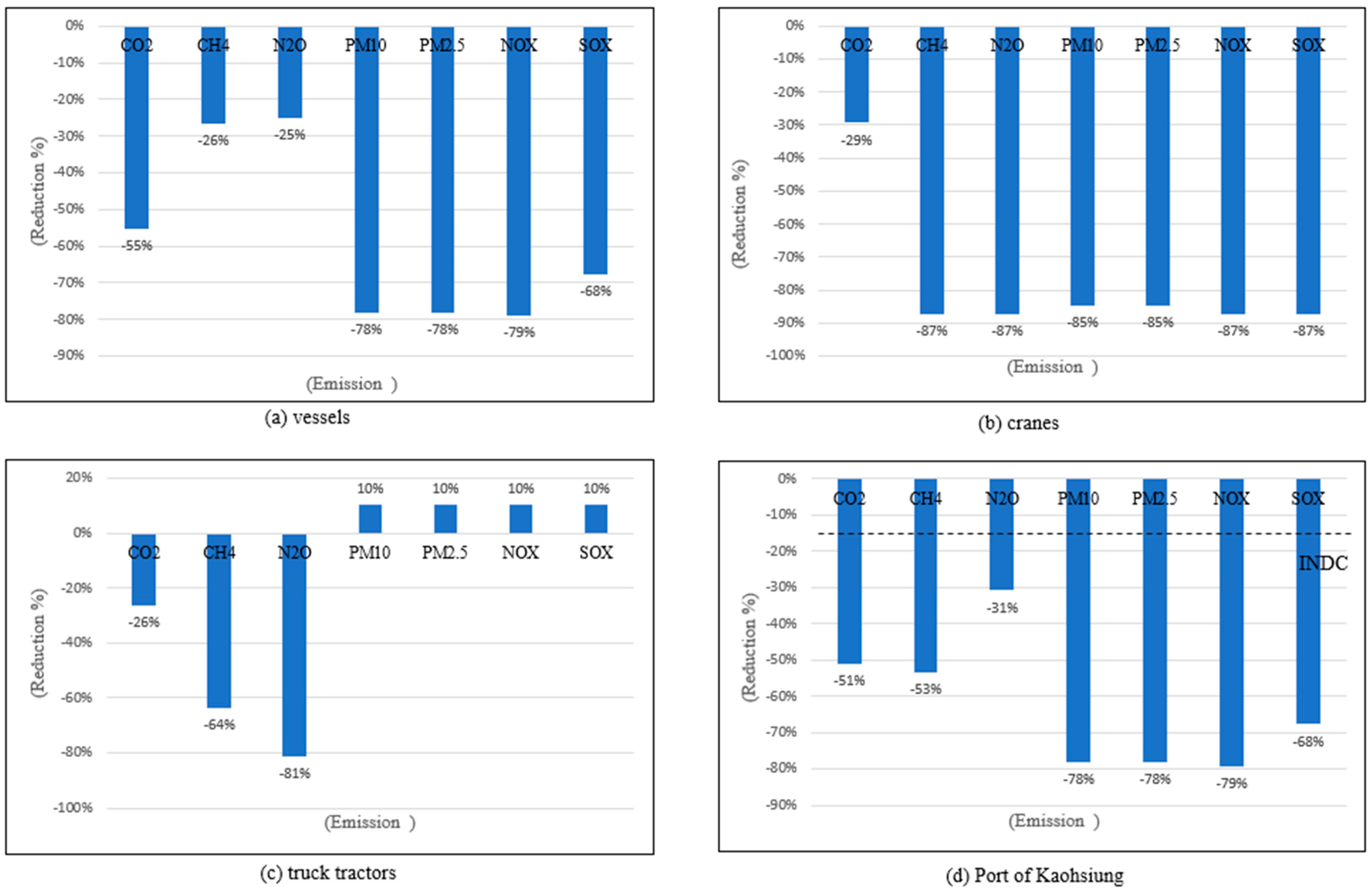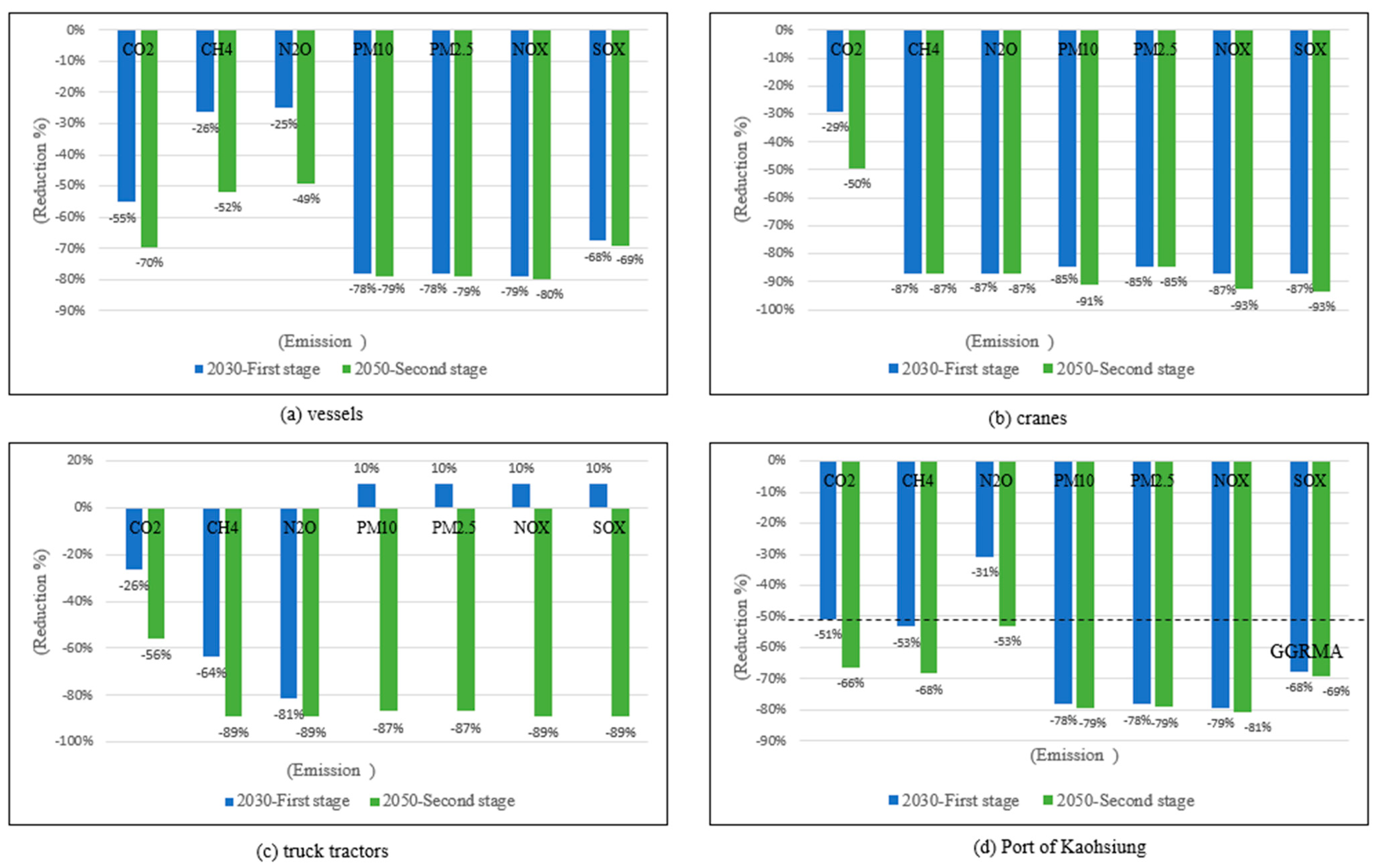Policies for Improving PM2.5 Particles and GHGs Emissions in a Maritime Port of Taiwan: Evidence Based on the INDC and GGRMA Regulations
Abstract
:1. Introduction
2. Materials and Methods
2.1. Data Collection
2.1.1. Vessel’s Data
2.1.2. Research Scope
2.1.3. Activities
2.2. Notation and Models
2.2.1. Notation
2.2.2. Model Formulation
Activity-Based Model for Vessels
Activity-Based Model for Truck Tractors
Activity-Based Model for Cranes
External Cost
2.2.3. Forecasting Model
The Grey Theory
Mean Absolute Percentage Error (MAPE)
3. Results
3.1. Emissions in a Business as Usual (BAU) Scenario
3.1.1. Emissions of Vessels
3.1.2. Emissions of Cranes
3.1.3. Emissions of Truck Tractors
3.1.4. Emissions of the Port of Kaohsiung
3.2. Emission Reduction Policies in the First Stage
3.2.1. Emissions of Vessels
3.2.2. Crane Emissions
3.2.3. Truck Tractor Emissions
3.2.4. Emissions in the Port of Kaohsiung
3.3. Emissions Due to Reduction Policies in the Second Stage
3.3.1. Vessel Emissions
3.3.2. Crane Emissions
3.3.3. Truck Tractor Emissions
3.4. Emissions Effects on External Cost
3.5. An Analysis of the Effect of Each Reduction Policy
3.6. Summary
4. Discussion
- (1).
- In the first stage, the reduction polices included requiring the deceleration of all vessels entering the Port of Kaohsiung, requiring vessels to use onshore power while in dock, converting all the truck tractors from diesel to LNG fuel, and electrifying all the bridge cranes in the port. The results show that CO2, CH4, N2O, PM10, PM2.5, NOx, and SOx could be reduced by 46%, 26%, 25%, 77%, 77%, 76%, and 68%, respectively.
- (2).
- In the second stage, the analyzed polices included the conversion of all the vessels from the use of heavy oil to LNG fuel, the conversion of all the LNG truck tractors to lithium-ion battery power, and the conversion of all the RTG cranes in the port to lithium-ion power. The results indicated that CO2, CH4, N2O, PM10, PM2.5, NOx, and SOx could be reduced by 57%, 59%, 53%, 79%, 79%, 80%, and 69%, respectively.
- (3).
- The analysis conducted in this study showed that these measures could reduce the external cost of air pollution in the Port of Kaohsiung by USD 1.1 billion in 2030 and USD 1.16 billion in 2050, respectively, when compared to Kaohsiung’s external costs in 2005.
- (4).
- An analysis of all the studied policies showed that OPS is the best way to reduce CO2, particulate matter, and harmful gases emitted by vessels berthing in the port. OPS could reduce CO2, PM10, PM2.5, NOx, and SOx by 40%, 71%, 71%, 72%, and 57%, respectively. On the other hand, requiring fuel conversion was the best policy for decreasing the greenhouse gases produced by vessels while navigating in the fairway. This policy could reduce CO2, CH4 and N2O by 32%, 35%, and 32%, respectively. Furthermore, carrying out the electrification of bridge cranes could reduce their emission inventory (CO2, CH4, N2O, PM10, PM2.5, NOx, and SOx) significantly, producing reductions of 29%, 87%, 87%, 85%, 85%, 87%, and 87%, respectively. Using battery-electric trucks was projected to decrease the emissions of truck tractors by 40%, 70%, 41%, 88%, 88%, 90%, and 90%, respectively.
5. Conclusions
Author Contributions
Funding
Institutional Review Board Statement
Informed Consent Statement
Data Availability Statement
Acknowledgments
Conflicts of Interest
References
- ICCT. Greenhouse Gas Emissions from Global Shipping, 2013–2015. 2017. Available online: https://www.theicct.org/publications/GHG-emissions-global-shipping-2013–2015 (accessed on 30 October 2018).
- IEA. CO2 Emissions from Fuel Combustion—Highlight. 2017. Available online: https://www.iea.org/publications/freepublications/publication/CO2EmissionsfromFuelCombustionHighlights2017.pdf (accessed on 28 December 2018).
- Review of Maritime Transportation. 2018. Available online: https://unctad.org/en/PublicationsLibrary/rmt2018_en.pdf (accessed on 22 October 2019).
- Corbett, J.J.; Winebrake, J.J.; Green, H.E.; Kasibhatla, P.; Eyring, V.; Lauer, A. Mortality from Ship Emissions: A Global Assessment. Environ. Sci. Tech. 2007, 41, 8512–8518. [Google Scholar] [CrossRef] [PubMed]
- Tian, L.; Ho, K.; Louie PK, K.; Qiu, H.; Pun, V.C.; Kan, H.; Yu, I.T.S.; Wang, T.W. Shipping emissions associated with increased cardiovascular hospitalizations. Atmos. Environ. 2013, 74, 320–325. [Google Scholar] [CrossRef]
- Xu, N.; Dang, Y.; Gong, Y. Novel grey prediction model with nonlinear optimized time response method for forecasting of electricity consumption in China. Energy 2017, 118, 473–480. [Google Scholar] [CrossRef]
- Mousavi, A.; Sowlat, M.H.; Hasheminassab, S.; Polidori, A.; Shafer, M.M.; Schauer, J.J.; Sioutas, C. Impact of emissions from the Ports of Los Angeles and Long Beach on the oxidative potential of ambient PM0.25 measured across the Los Angeles County. Sci. Total Environ. 2019, 651, 638–647. [Google Scholar] [CrossRef]
- Tzannatos, E. Cost assessment of ship emission reduction methods at berth: The case of the Port of Piraeus. Greece. Mari. Pol. Man. 2010, 37, 427–445. [Google Scholar] [CrossRef]
- McArthur, D.P.; Osland, L. Ships in a city harbour: An economic valuation of atmospheric emissions. Trans. Res. Part D Transp. Environ. 2013, 21, 47–52. [Google Scholar] [CrossRef]
- Song, S. Ship emissions, social cost and eco-efficiency in Shanghai Yangshan port. Atmos. Environ. 2014, 82, 288–297. [Google Scholar] [CrossRef]
- Tichavska, M.; Tovar, B. Environmental cost and eco-efficiency from vessel emissions in Las Palmas Port. Trans. Res. Part E Log. Trans. Rev. 2015, 83, 126–140. [Google Scholar] [CrossRef]
- Chatzinikolaou, S.D.; Oikonomou, S.D.; Ventikos, N.P. Health externalities of ship air pollution at port—Piraeus port case study. Trans. Res. Part D Trans. Environ. 2015, 40, 155–165. [Google Scholar] [CrossRef]
- Maragkogianni, A.; Papaefthimiou, S. Evaluating the social cost of cruise ships air emissions in major ports of Greece. Trans. Res. Part D Transp. Environ. 2015, 36, 10–17. [Google Scholar] [CrossRef]
- IMO. Low Carbon Shipping and Air Pollution Control. 2018. Available online: http://www.imo.org/en/MediaCentre/HotTopics/GHG/Pages/default.aspx (accessed on 18 October 2020).
- López-Aparicio, S.; Tonnesen, D.; Thanh, T.N.; Neilson, H. Shipping emissions in a Nordic port: Assessment of mitigation strategies. Trans. Res. Part D Transp. Environ. 2017, 53, 205–216. [Google Scholar] [CrossRef]
- Sciberras, E.A.; Zahawi, B.; Atkinson, D.J.; Juando, A.; Sarasquete, A. Cold ironing and onshore generation for airborne emission reductions in ports. J. Eng. Mari. Environ. 2016, 230, 67–82. [Google Scholar] [CrossRef] [Green Version]
- Chang, C.C.; Jhang, C.W. Reducing speed and fuel transfer of the Green Flag Incentive Program in Kaohsiung Port Taiwan. Trans. Res. Part D Trans. Environ. 2016, 46, 1–10. [Google Scholar] [CrossRef]
- Berechman, J.; Tseng, P.H. Estimating the environmental costs of port related emissions: The case of Kaohsiung. Trans. Res. Part D Trans. Environ. 2012, 17, 35–38. [Google Scholar] [CrossRef]
- Cullinane, K.; Tseng, P.H.; Wilmsmeie, G. Estimation of container ship emissions at berth in Taiwan. Intern. J. Sust. Trans. 2016, 10, 466–474. [Google Scholar] [CrossRef]
- Nunes, R.A.O.; Alvim-Ferraz, M.C.M.; Martins, F.G.; Sousa, S.I.V. The activity-based methodology to assess ship emissions—A review. Environ. Poll. 2017, 231, 87–103. [Google Scholar] [CrossRef]
- Alver, F.; AyhanSaraç, B.; Şahin, Ü. Estimating of shipping emissions in the Samsun Port from 2010 to 2015. Atmos. Poll. Res. 2018, 9, 822–828. [Google Scholar] [CrossRef]
- World Shipping Council. Top 50 World Container Ports. 2018. Available online: http://www.worldshipping.org/about-the-industry/global-trade/top-50-world-container-ports (accessed on 29 December 2020).
- EPA. Environmental Policy Monthly 2017. 2017. Available online: https://www.epa.gov.tw/DisplayFile.aspx?FileID=C6A7FFE5F42F73AB&P=306cd6a2-f843-4704-8888-1367ab0b2911 (accessed on 16 April 2021).
- EPA. Greenhouse Gas Reduction and Management Act 2017. 2018. Available online: https://ghgrule.epa.gov.tw/greenhouse_control/greenhouse_control (accessed on 16 April 2021).
- Ministry of Transportation and Communications. Marine Traffic. 2018. Available online: https://www.motc.gov.tw/en/ (accessed on 21 June 2019).
- POLB. Emissions Full Report 2009. 2009. Available online: http://www.polb.com/civica/filebank/blobdload.asp?BlobID=7390 (accessed on 28 June 2018).
- Miola, A.; Ciuffo, B. Estimating air emissions from ships: Meta-analysis of modelling approaches and available data sources. Atmos. Environ. 2011, 45, 2242–2251. [Google Scholar] [CrossRef]
- Bouman, E.A.; Lindstad, E.; Rialland, A.I.; Stromman, A.H. State-of-the-art technologies, measures, and potential for reducing GHG emissions from shipping—A review. Trans. Res. Part D Trans. Environ. 2017, 52, 408–421. [Google Scholar] [CrossRef]
- Chen, D.; Wang, X.; Nelson, P.; Li, Y.; Zhao, Y.; Lang, J.; Zhou, Y.; Guo, X. Ship emission and its impact on the PM2.5 air pollution in Qingdao Port, North China. Atmos. Environ 2017, 166 (Suppl. C), 351–361. [Google Scholar] [CrossRef]
- ITF. ITF Transport Outlook 2015. 2015. Available online: https://www.itf-oecd.org/sites/default/files/docs/14outlook-chapter4.pdf (accessed on 18 November 2018).
- VOWTAP. Virginia Offshore Wind Technology Advancement Project. 2014. Available online: https://www.osti.gov/servlets/purl/1341588 (accessed on 21 June 2018).
- POLB Press Releases. 2017. Available online: http://www.polb.com/news/archive/2017.asp (accessed on 22 October 2018).
- USEPA Annual Report. Virginia Offshore Wind Technology Advancement Power. 2010. Available online: https://www.epa.gov/sites/production/files/2013-12/documents/annual-report-2010.pdf.VOWTAP (accessed on 27 December 2017).
- IPCC. Climate Change 2014: Fifth Assessment Report. 2014. Available online: Http://www.ipcc.ch/report/ar5/ (accessed on 20 January 2018).
- Ding, S.; Dang, Y.G.; Li, X.M.; Wang, J.J.; Zhao, K. Forecasting Chinese CO2 emissions from fuel combustion using a novel grey multivariable model. J. Clea. Prod. 2017, 162, 1527–1538. [Google Scholar] [CrossRef]
- Wang, Z.X.; Hao, P. An improved grey multivariable model for predicting industrial energy consumption in China. App. Math. Model. 2016, 40, 5745–5758. [Google Scholar] [CrossRef]
- Kim, S.; Kim, H. A new metric of absolute percentage error for intermittent demand forecasts. Int. J. Forecast. 2016, 32, 669–679. [Google Scholar] [CrossRef]
- Nageem, R.; Jayabarathi, R. Predicting the power output of a Grid-Connected solar panel using multi-input support vector regression. Procedia Comput. Sci. 2017, 115, 723–730. [Google Scholar] [CrossRef]
- Lewis, E. Control of Body Segment Differentiation in Drosophila by the Bithorax Gene Complex. Prog. Clin. Biol. Res. 1982, 85, 269–288. [Google Scholar] [PubMed]
- Cariou, P. Is slow steaming a sustainable means of reducing CO2 emissions from container shipping? Trans. Res. Part D Trans. Environ. 2011, 16, 260–264. [Google Scholar] [CrossRef]
- Winnes, H.; Styhre, L.; Fridell, E. Reducing GHG emissions from ships in port areas. Res. Transp. Bus. Manag. 2015, 17, 73–82. [Google Scholar] [CrossRef] [Green Version]
- Mani, S.A.; Mani, F.S.; Kumar, A.; Shah, S.; Peltier, R. E Traffic related PM2. 5 air quality: Policy options for developing Pacific Island countries. Trans. Res. Part D Transp. Environ. 2020, 87, 102519. [Google Scholar] [CrossRef]
- Ovrum, E.; Bergh, T.F. Modelling lithium-ion battery hybrid ship crane operation. Appl. Energy 2015, 152, 162–172. [Google Scholar] [CrossRef]
- Iris, Ç.; Lam, J.S.L. A review of energy efficiency in ports: Operational strategies, technologies and energy management systems. Renew. Sustain. Energy Rev. 2019, 112, 170–182. [Google Scholar] [CrossRef]
- Sen, B.; Ercan, T.; Tatari, O. Does a battery-electric truck make a difference?—Life cycle emissions, costs, and externality analysis of alternative fuel-powered Class 8 heavy-duty trucks in the United States. J. Clean. Prod. 2017, 141, 110–121. [Google Scholar] [CrossRef]
- Sharafian, A.; Blomerus, P.; Mérida, W. Natural gas as a ship fuel: Assessment of greenhouse gas and air pollutant reduction potential. Energy Policy 2019, 131, 332–346. [Google Scholar] [CrossRef]
- Iris, Ç.; Lam, J.S.L. Optimal energy management and operations planning in seaports with smart grid while harnessing renewable energy under uncertainty. Omega 2021, 103, 102445. [Google Scholar] [CrossRef]





| Vessel Type | Container Ship | Bulk Carrier | Tanker | Ferry |
|---|---|---|---|---|
| Vessel name | Ever Balmy | Roadrunner Bulker | Bow Fuling | Tai HWA |
| IMO refer number | 9,786,944 | 944,415 | 9,504,190 | 8,811,027 |
| Deadweight tonnage (ton) | 37,563 | 57,809 | 9156 | 2296 |
| Design speed (knots/h) | 17.8 | 14 | 13.5 | 15 |
| The median tonnage of vessels’ type (ton) | 20,000–39,999 | 40,000–69,999 | 5000–9999 | 1000–4999 |
| Index | Description | Unit |
|---|---|---|
| i | Vessel types, where i = 1~4 (1 = container ships, 2 = bulk ships, 3 = tankers, 4 = ferries) | |
| j | Activity mode, where j = 1~3 (1 = fairway, 2 = maneuvering, 3 = berth). | |
| k | Emission type, where k = 1~3 (1 = vessels, 2 = truck tractors, 3 = cranes) | |
| Variables | Description | Unit |
| Total emission of vessels | ton | |
| Emission of i vessels in j activity mode | ton | |
| Maximum continuous rating of engine | kw | |
| Vessel actual speed of i type in j activity mode | knot | |
| Vessel maximum speed in i type | knot | |
| Vessel traveling distance in j activity mode | km | |
| Time in j activity mode | hour | |
| Engine load factors in j activity mode | % | |
| Vessel emission factors | (g-kw/h) | |
| Number of vessels in i type | ||
| Truck tractors missions | ton | |
| Engine horsepower of truck tractors | kw | |
| Truck tractor traveling time | hour | |
| Truck tractor engine load factors | % | |
| Truck tractor emission factors | (g-kw/h) | |
| Number of truck tractors | ||
| Emission of cranes | ton | |
| Crane engine horsepower | kw | |
| Crane Engine load factors | % | |
| Crane operating time | hour | |
| Emission factors of crane | (g-kw/h) | |
| Number of cranes | ||
| EEC | External emissions cost | $USD |
| ECF | Emission cost factors | $USD/ton |
| a | Developing coefficient | |
| b | Grey input | |
| MAPE | Mean Absolute Percent Error | |
| Real number of ship calls into the Port of Kaohsiung in year t. | ||
| Predicted number of ship calls into the Port of Kaohsiung in year t. |
| Emissions (Million USD) | CO2 | CH4 | N2O | PM10 | PM2.5 | NOx | SOx | Total (Billion USD) |
|---|---|---|---|---|---|---|---|---|
| BAU scenario-2005 | 65.00 | 0.036 | 0.70 | 324.04 | 290.30 | 446.73 | 410.21 | 1.53 |
| BAU scenario-2030 | 62.21 | 0.038 | 0.66 | 293.72 | 263.52 | 411.71 | 368.50 | 1.40 |
| BAU scenario-2050 | 60.07 | 0.037 | 0.63 | 281.28 | 252.42 | 395.26 | 352.41 | 1.34 |
| The first stage-2030 | 35.02 | 0.026 | 0.53 | 75.03 | 67.77 | 109.15 | 132.56 | 0.42 |
| The second stage-2050 | 24.21 | 0.012 | 0.33 | 67.93 | 60.83 | 88.95 | 126.75 | 0.37 |
| Policy | CO2 | CH4 | N2O | PM10 | PM2.5 | NOx | SOx |
|---|---|---|---|---|---|---|---|
| Vessel speed reduction | −16% | −18% | −16% | −16% | −16% | −16% | −16% |
| OPS | −40% | 0% | 0% | −71% | −71% | −72% | −57% |
| Vessel fuel conversion to LNG | −32% | −35% | −32% | −4% | −4% | −4% | −4% |
| Bridge cranes electrification | −29% | −87% | −87% | −85% | −85% | −87% | −87% |
| Lithium-ion battery RTG | −29% | 0% | 0% | −43% | 0% | −43% | −48% |
| Truck tractor fuel conversion to LNG | −26% | −64% | −81% | 10% | 10% | 10% | 10% |
| Battery-electric truck conversion | −40% | −70% | −41% | −88% | −88% | −90% | −90% |
Publisher’s Note: MDPI stays neutral with regard to jurisdictional claims in published maps and institutional affiliations. |
© 2021 by the authors. Licensee MDPI, Basel, Switzerland. This article is an open access article distributed under the terms and conditions of the Creative Commons Attribution (CC BY) license (https://creativecommons.org/licenses/by/4.0/).
Share and Cite
Chang, C.-C.; Tsai, Y.-A. Policies for Improving PM2.5 Particles and GHGs Emissions in a Maritime Port of Taiwan: Evidence Based on the INDC and GGRMA Regulations. J. Mar. Sci. Eng. 2021, 9, 1315. https://doi.org/10.3390/jmse9121315
Chang C-C, Tsai Y-A. Policies for Improving PM2.5 Particles and GHGs Emissions in a Maritime Port of Taiwan: Evidence Based on the INDC and GGRMA Regulations. Journal of Marine Science and Engineering. 2021; 9(12):1315. https://doi.org/10.3390/jmse9121315
Chicago/Turabian StyleChang, Ching-Chih, and Yi-An Tsai. 2021. "Policies for Improving PM2.5 Particles and GHGs Emissions in a Maritime Port of Taiwan: Evidence Based on the INDC and GGRMA Regulations" Journal of Marine Science and Engineering 9, no. 12: 1315. https://doi.org/10.3390/jmse9121315
APA StyleChang, C.-C., & Tsai, Y.-A. (2021). Policies for Improving PM2.5 Particles and GHGs Emissions in a Maritime Port of Taiwan: Evidence Based on the INDC and GGRMA Regulations. Journal of Marine Science and Engineering, 9(12), 1315. https://doi.org/10.3390/jmse9121315





